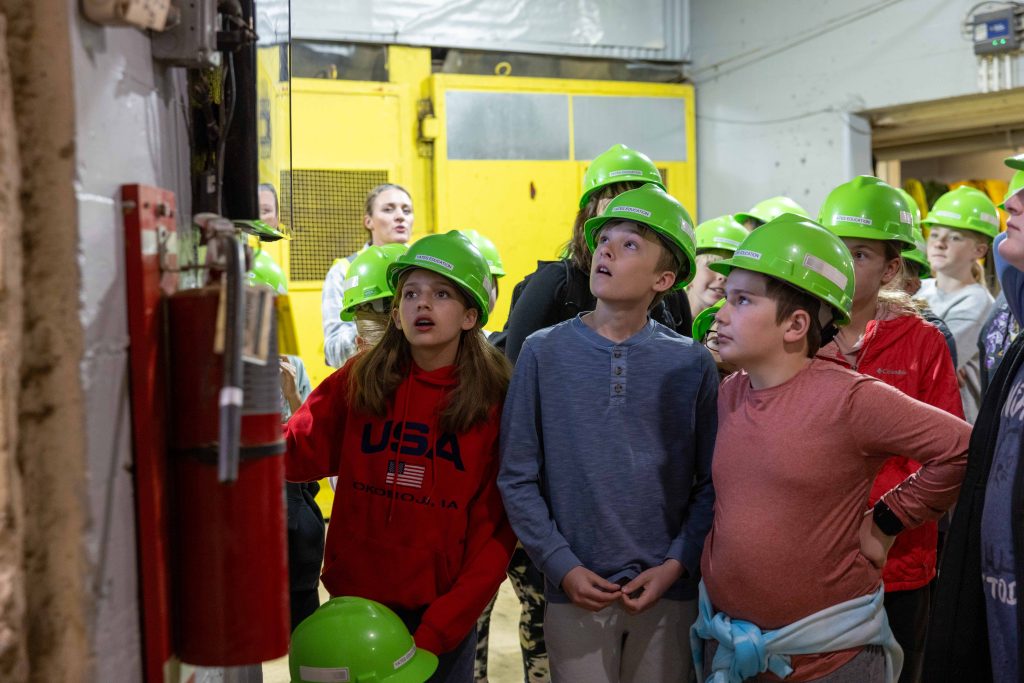Each year, a small but mighty team of educators at the Sanford Underground Research Facility (SURF) fan out across the state and region to bring hands-on STEM based activities to thousands of students in K-12 classrooms. This school year, SURF educators spent time engaged with more than 20,000 students alongside hundreds of teachers in professional development activities.
Lead, SD (June 4, 2025) — For Nicol Reiner, one of the best parts about being in front of 150 sixth graders who are enthralled in a STEM-based activity are the few quiet kids, often in the back of the room.
“Maybe they’re not brave enough to ask their question. But they really want to know a little bit more. So, at the end of the class, when everybody’s exiting, they come towards the front, and they want to know how to get more information, they want to know how they can become a scientist, or engineer, or educator, or technician at SURF someday. I love that so much,” Reiner said. “Because, you know you hooked them. You know they just needed someone to connect with.”
Creating those moments of inspiration that can help young people engage with the world around them and open the door to lifelong learning, is one part of what the education team at SURF does throughout the school year.
Reiner is the director of education and outreach at SURF. She says this year, the SURF education team spent lots of time on the road in front of classrooms, school assemblies, and special events.
“We plan out weeks on the road during the year where we visit as many schools as we can in a four- to five-day time frame. This year, we had to buy voice amplifiers for the staff, because when you do this every day for weeks you don’t have any voice left,” Reiner said.
One reason SURF educators keep getting invited back year after year to small and large schools across the state is the local connection they bring to students.
“You can teach so that science is about far-off places or just content out of a textbook. But it’s so much better, when young people say, ‘Oh, I just did this cool thing, and it’s related to the underground lab in Lead, South Dakota, or it’s related to something in my community or my backyard,’” Reiner said. “They love when folks can come in and make a relevant connection to something that’s possible, or in a student’s life, or in a student’s region. Schools recognize that making the subject relevant and relatable to students is a very important part of learning.”
Connecting students to learning about STEM applications in their own backyard increases knowledge retention, and is also aimed at making subjects like math, science, engineering and technology accessible for all students.
“We wantall students to know that STEM could be their future. We don’t ever want there to be a child who thinks that STEM is not possible for them,” Reiner said. At the same time, we also want all of them to understand it well enough that those who don’t want to make STEM a career still feel like they can navigate their world, that they can understand challenges in their community, and that they can feel like they have the equipment and tools in their toolbox to be able to start to tackle issues that matter to them. Community problems are typically solved in communities, and everyone needs to have STEM literacy to be able to understand what’s happening, the data that’s needed, and how things work together.”
The bulk of building STEM literacy in our society falls on the backs of our teachers. A big part of SURF’s annual efforts to bolster education includes robust resources for teacher professional development.
“It takes hundreds, and I literally mean hundreds of hours, to actually write the kind of professional development that we do. We make it hands-on for teachers. They all say they can’t believe how fast the day went, because they’re constantly engaged,” Reiner said. “We do it because that’s what we’re asking them to do with students. You can’t ask them to do something you’re not willing to do. And at the same time, teachers don’t have hundreds of hours to plan lessons for kids, so how do we make it doable? How do we make it work for them? Because that is a huge challenge, especially in our small, rural schools that don’t have the same resources as others. It’s why we not only offer professional development, but also free curriculum resources that are standards aligned and ready to use in classrooms.”
Reiner recognizes that SURF’s small but hardworking team of educators is just one of the many organizations and institutions who support teachers and schools in the region, and that the efforts of everyone are vital in our combined future.
The visionaries who established SURF made education a critical component of its overall mission. The efforts of SURF’s education team echo this longstanding commitment to elevate science literacy, foster curiosity, and empower students and teachers alike. It’s true that any one of the 20,000 students reached this school year, including those quiet kids at the back of the room, could someday be researchers, engineers, educators, or technicians working at America’s Underground Lab.


